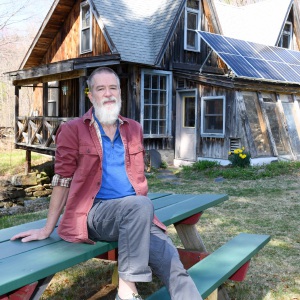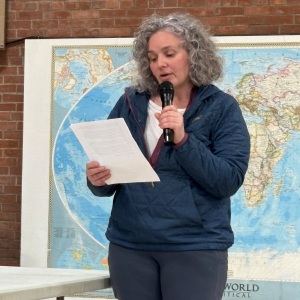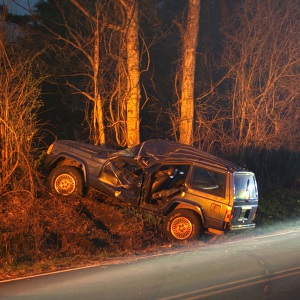Tour highlights UMass’ clean energy initiatives, leadership
| Published: 10-22-2024 3:31 PM |
AMHERST — Continued efforts to increase the clean energy workforce for offshore wind and “climate tech” in general in Massachusetts are looking to Denmark as a possible model where, even with a smaller population than the Bay State, the wind energy sector is providing direct employment to 100,000 people.
At the University of Massachusetts Amherst, the recently launched Academic Center for Reliability and Resilience of Offshore Wind aims to drive workforce development and innovation while serving as an academic and training hub for the offshore wind industry, according to Matt Lackner, professor of mechanical engineering and director of the Amherst Wind Energy Center, an entity founded in 1972.
“The idea is to tailor the education to industry needs,” Lackner said. “This will be the only true comprehensive center for offshore wind.”
Getting ARROW up and running, and having UMass students and researchers leading a multi-university project to bolster the workforce and lower costs for developers by reducing uncertainty — such as by finding ways to improve wind turbine support structures in the face of stronger hurricanes — is an $11.7 million investment, a budget that depends on $4.75 million in support from the Massachusetts Clean Energy Center, a quasi-public economic development agency.
MassCEC CEO Emily Reichert was on campus last week to hear from Lackner and others who are leading clean energy efforts, and to see first-hand the laboratory work taking place on campus. That included a visit to the Water and Energy Technology Center, where numerous private start-ups each year do experiments related to drinking water and wastewater.
Reichert said the idea is to offer support for a professional workforce to supply the clean energy industry with the next generation of leaders and meet the state’s goal of “accelerating decarbonization.”
“What we do is help solve problems that keep us from getting to scale,” Reichert said. “We do a lot of pilot studies and things that are stopping us from getting to scale.”
With support from the Legislature, Massachusetts, with just over 7 million residents, now has 108,000 direct clean energy workers, representing an 80% growth since 2010. Reichert said this support is also for a climate technology corridor, similar to the life sciences initiative from 15 years ago.
Article continues after...
Yesterday's Most Read Articles
 Lesbian bar opens in Greenfield: Last Ditch is the new space for the Valley’s queer community
Lesbian bar opens in Greenfield: Last Ditch is the new space for the Valley’s queer community
 Warwick residents, Selectboard, frustrated by internet connection delays
Warwick residents, Selectboard, frustrated by internet connection delays
 Petition seeks removal of Tucker Jenkins from Shelburne Police
Petition seeks removal of Tucker Jenkins from Shelburne Police
 Turners Falls man pleads guilty to child porn charges
Turners Falls man pleads guilty to child porn charges
 Driver taken by helicopter following Warwick crash
Driver taken by helicopter following Warwick crash
 PHOTOS: ‘Overpass Day’ held to protest Trump administration
PHOTOS: ‘Overpass Day’ held to protest Trump administration
Among those joining the discussion at the Kellogg Conference Room at Engineering Lab II were state Sen. Jo Comerford, D-Northampton; state Rep. Mindy Domb, D-Amherst; Dwayne Breger, director of the Clean Energy Extension; Erin Baker, professor of mechanical and industrial engineering and faculty director of the Energy Transition Institute; Sanjay Raman, dean of the College of Engineering; and Michael Fox, dean of the College of Natural Sciences.
Reichert said there are tons of good intentions and good work going on in the state in partnership with the Department of Energy Resources to identify the strengths of each region, from Cape Cod to the Berkshires.
“How do we think about the entire state from the very beginning?” Reichert said. “I think we can lead the way.”
Her agency’s original focus was on solar and then onshore wind, but has moved on to fund case studies that may be off the norm, to confront challenges and begin early-stage new innovations. As an example, she cited the difficulties that may face families living in an urban triple-decker who want to move to renewable energy but may be dealing with three separate owners, or those who live in a multi-family home but have no garage to charge an electric vehicle.
Catalyst grants to get research out of the lab where it can be put to use and for climate tech to address climate change by reducing emissions are priorities, as are making systems more resilient to climate change effects and providing money for industry research, so species and ecosystems can be protected.
The support for offshore wind, in addition to workforce and supply-chain development, has included development of ports, including a wind staging and deployment facility in New Bedford and another planned for Salem.
Breger praised MassCEC for its support of UMass over the years, saying that “MassCEC has done a tremendous job in moving clean energy forward.”
Baker gave a quick summary of the on-campus Energy Transition Institute and its work to integrate clean energy technology and social justice, with a focus on Holyoke. This includes decommissioning natural gas pipelines and doing a case study on a community energy project, as well as partnering with El Corazon/ The Heart of Holyoke through Elevate, a project that prioritizes equity values in the transition of the energy system.
Raman told Reichert that sustainability is in the DNA of the UMass campus, pointing to its Carbon Zero initiative, which seeks to transition the entire campus to 100% renewable energy. Raman said he would also love to talk to MassCEC about bringing companies to Amherst to work alongside researchers, rather than them heading to the Kendall Square innovation district in Cambridge.
Opportunities do exist in the Pioneer Valley, Reichert said, pointing to Holyoke as having a cluster of innovation startups and space to add more.
Following the conversation, Reichert toured the Water and Energy Technology Center, or WET Lab, near the Amherst’s Wastewater Treatment Plant, where a number of start-up clean energy companies are working on projects.
Research engineer Patrick Wittbold explained that companies can rent space for a day, a year or longer, with six to 12 projects coordinated annually with UMass staff and students.
But even with important work, like testing for forever chemicals in drinking water, it is a cramped 1,200-square-foot building and out of date, and even closed for a time before reopening in 2015. There are plans for a $6 million or more update that would mean a more advanced laboratory, better ventilation, a conference room for teaching and training, and more suitable space for the work happening inside. That has received state earmarks and other pledges.
Caitlyn Butler, associate dean of research and graduate affairs in the College of Engineering, said the larger, more modern building will benefit and hasten start-ups.
“A new facility would allow streamlined project execution,” Butler said. “We could offer a lot more support to a lot more companies.”
David Reckhow, professor of civil and environmental engineering, said the department has appreciated MassCEC for past support for the WET Center, including a feasibility study for the creation of a water-testing site at UMass.










 White House slashes funds for asthma sufferers in western Mass.
White House slashes funds for asthma sufferers in western Mass.  ‘Fill bellies, feed hearts’: Second Helpings celebrates 25 years of providing food, community
‘Fill bellies, feed hearts’: Second Helpings celebrates 25 years of providing food, community  PHOTOS: Friends of fish
PHOTOS: Friends of fish
